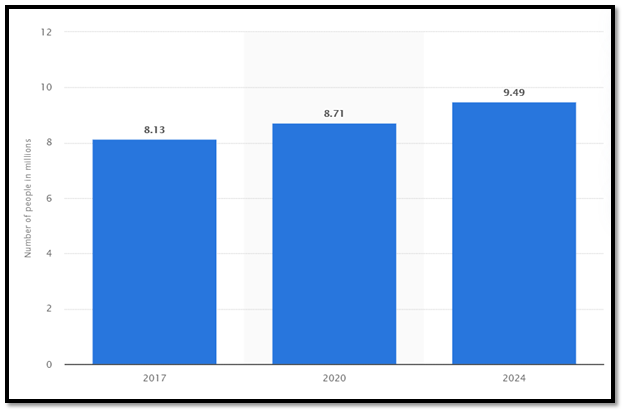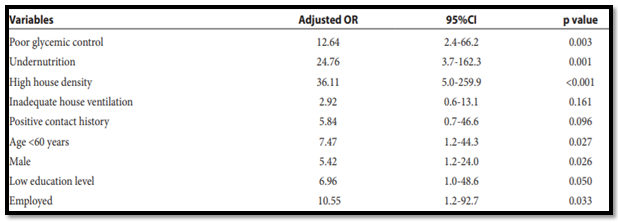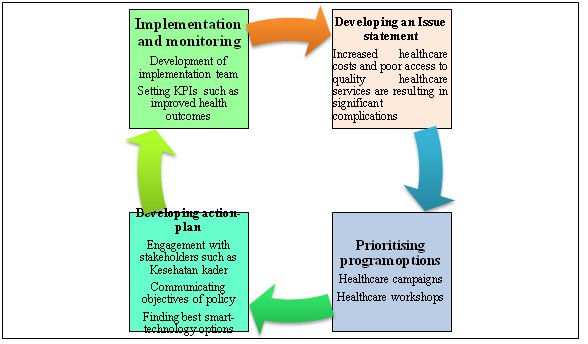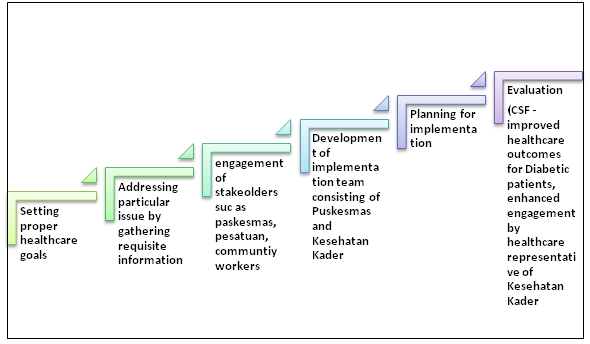Healthcare Policy Assignment Addressing the Issue of Diabetes in Indonesia
Question
Task:
Healthcare Policy Assignment Task: Policy brief on a cause of action
Working in public health often requires the formulation of evidence-based briefs and reports to move forward with public health policies and actions.
One of your report findings has been flagged as actionable by a World Health Organization (WHO) consultant, congratulations! To start your internship, the WHO consultant has asked you to prepare a policy brief on how one of your findings can be put into action.
Identify one of your investigation findings from Assessment 2 and formulate a realistic policy action. Review the steps of policy development and critically reflect on who the multidisciplinary contributors would be and potential hurdles which may impede the public health action. Present this using provided policy brief template.
This healthcare policy assignmentforms the third and fourth steps, Plan and Political Commitments in policy development as depicted in the policy development process figure below.
Task
Your policy action brief should follow the provided Policy Brief template, including your diagram of the proposed steps and a conclusion (2000 words in total).
Select and present an evidence-based outline of the chosen health disparity/concern and one related health determinant you made in Assessment 2. This discussion should address a part of your initial finding (e.g. increasing contraception availability to address sexually transmitted disease or increasing community education on transmission of tuberculosis).
Conduct further research and critically review policies and actions already in place to address the health disparity and justify the action plan you are recommending to address the health disparity. (500 words) Present your public health policy action to address the health disparity. Identify and justify core health organisations, country and community contributors, resources and infrastructures required for this action.
Present a coherent diagram to address the problem which demonstrates the steps for the action plan in a logical sequence. (200 words)
Present and summarise your findings, and recommended action plan in your conclusion. (300 words)
Answer
1. Introduction
1.1 Problem statement
Diabetes has been selected as a health concern, which has become one of significant reasons of death in Indonesia. Approximately 8.71 million of people of its entire population are currently suffering from Diabetes and it is projected to increase significantly by 2024 (Statista, 2021). Most prevalent variant of Diabetes in this country is Type-2 Diabetes. Numerous barriers are preventing people of this country to access quality healthcare for getting proper treatment. High level of urbanisation in this country is responsible for rising diabetes issues; however, less than one percent of people suffering from this disease can access proper treatment.

Figure 1: Continuous increase in number of diabetic patients in Indonesia
(Source: Statista, 2021)
1.2 Improving quality of healthcaresystemfor controlling Diabetes by increasing service accessibility and affordability through technology implementation Health-determinant, which should be considered for addressing this disease, is Healthcare. It includes elements such as affordability, quality, education and food. In many cases, due to poor quality or inaccessibility to proper care services cause comorbidity factors to get unnoticed. Various factors, which are responsible for leading to comorbidity include low level of education, lack of proper nutrition and so on (Dewiet al. 2017).
People living in this country are often unable to access proper healthcare services due to lack of affordability, poor access to services and so on. Therefore, implementation of a “Technology-based affordablePublic Healthcare policy” could be highly beneficial for improving accessibility of Diabetic patients to public healthcare services.

Figure 2: Study has found these factors to be responsible for comorbidity
(Source: Dewiet al. 2017)
Technology-based public-Healthcare policies can aid in improving care quality significantly by empowering and educating healthcare workers so that they can provide best quality treatment. As cited by Forchuket al. (2021), smart healthcare-technology can promote good quality of lives by improving health outcomes.
2. Recommendation
2.1 Review of existing healthcare policies and justification on recommended action plan
Indonesian Diabetic-Association has been developed for providing community training on Diabetes Prevention and control (Worlddiabetesfoundation, 2021). Besides that, in 2010, the government of this country initiated a “prevention program” for controlling and preventing chronic diseases such as Hypertension and Diabetes. However, this country has not implemented any proper policy for educating people on ways of managing Diabetes.As cited by Pulunganet al. (2021), proper education support programs should be conducted for educating people regarding insulin use, nutrition regulation and so on. In Indonesia no such programs are conducted that is worsening the problem in this country. Apart from this, due to lack of proper Diabetes Management Policy no proper guideline has been established for providing quality treatment to Diabetic Patients. Doctors and clinicians are often unaware of standard guidelines of Diabetes Treatment, which results in delivery of ineffective healthcare services. Absence of proper healthcare policy for providing need-based treatment for controlling Diabetes has resulted in high rate of mortality in this country.
However, a non-governmental association, Persatuanhas been developed as national organisation for promoting Diabetes care in this country (Idf.org, 2021).This organisation arranges camps and seminars for educating people suffering from this disease to control their issues through proper treatment. Indonesian Government has not yet implemented any policy for ensuring affordable and accessible healthcare services for people living with Diabetes. Therefore, a “Technology-based Public Healthcare Policy” can bring significant improvement in ensuring better management and prevention of Diabetes in Indonesia. As cited by Stevenson et al. (2018), technology-based interventions in Australia had improved healthcare outcomes on Diabetic people as it ensured improved access to healthcare services. Thus, implementation of a “Technology-based public health policy” would be highly beneficial for ensuring significant improvement in health outcomes of Diabetic patients. Implementation of smart digital technologies such astelehealth services would improve patients’ access to quality healthcare services.
Besides that,smart technologies can reduce costs of providing quality healthcare services which can help healthcare organisations to provide cheap or affordable healthcare services to their patients. This policy implementation would include a range of different healthcare awareness programs, which would educate people to get proper understanding of best possible ways of controlling or managing Diabetes. Collaborative working with organisations such as “Persatuan” will aid in implementing healthcare programs or workshops successfully.
Technology-based healthcare programs would promote ways of self-management of chronic diseases such as Diabetes, which will be an affordable way to manage Diabetes at first stage (Appuswamy&Desimone, 2020).Doctors will have clear insight into patients’ past information using smart healthcare data-recording system that would aid them in providing best quality healthcare services to the patients. This policy would adhere to Affordability Act” that aimed at providing affordable health-care services all citizens living in Indonesia. A part of this policy will aim at engaging insurance companies to make them aware of the mentioned legislation and cover Diabetes being a serious health concern. Hence, implementation of this policy action-plan is expected to manage Diabetes in this country in an effective manner.
2.2 Public-health policy action and identification of contributors or key stakeholders
Presenting health-policy actions
• Survey Findings
As shown in figure 1, in 2020, 8.71 million people had to suffer from this disease (Statista, 2021). It is estimated to increase significantly by 2024.
• Analysis
In this stage, an evidence-based customised public-health policy-model is developed for ensuring successful implementation. This model includes following elements:
Developing an Issue statement
“Increased healthcare costs and poor access to quality healthcare services are resulting in significant complications in managing Diabetes in Indonesia, which calls for implementation of a proper policy that would promote affordability and would improve accessibility to healthcare services.”

Figure 3: Evidence-based health-policy model
Prioritising program options
Healthcare campaigns
Healthcare workshops
Developing action-plan
Engagement with stakeholders such as Non-government association (Persatuan), community
healthcare-workers, elected officials
- Communicating objectives of policy
- Finding best smart-technology options for improving accessibility and affordability
Implementation and monitoring
- Development of implementation team
- Setting KPIs
Planning
In this stage, actions that will be takenfor enhancing public-health awareness will beplanned.Thisincludescontinuous workshops and campaigns for making people aware of importance of building a proper healthcare framework for enhancing accessibility to healthcare system through implementation of a policy. It will include generation of set of different scenarios, which will reflect probable impact of technology implementation in existing healthcare framework (Yu et al. 2017).
|
Scenarios |
Characteristics |
Alternative actions to cope with uncertainties in each scenario |
|
1.Increase in trust of Diabetic patients on tele-healthcare system and Technology-based public-healthcare policy as it can help them to get easy and cost-efficient access to healthcare serviceswould be ensured. However, not all people are comfortable with technologies which can be a cause of dissatisfaction |
Tele-healthcare services are easily accessible by all from their personal devices. As cited by Camplinget al. (2017), telehealthcare services can enhance cost-effectiveness of treatment, which is beneficial especially for older population. |
Community health-workers need to conduct training prorams for making people aware of use of telehealth services. |
|
2. Technologies can help doctors and medical practitioners to get access to patient information easily that would help in providing quality treatment. However, in some cases, technology implementation can enhance overall cost of healthcare services, which can cause healthcare organisations to face fund constraints, and they can face problems in providing affordable healthcare services to patients. Therefore, healthcare organisations can be reluctant to implement these technologies. |
In most cases, poor documentation of health information causes problems in providing quality services. However, implementation of advanced technology would enhance doctors’ access to patients’ past information (such as information regarding comorbidity) that would aid in improving quality of care services. |
As one of the fundamental objectives of “Technology-based and affordable Public-Healthcare Policy” is to enhance public affordability to care services by reducing healthcare costs, hence, there should not be any provision of increased healthcare cost through implementation of technology.Smart Technologies should be implemented which are less cost-consuming as compared to others (Al-Khafajiyet al. 2019). |
|
3. Lack of public trust and awareness regarding policy |
This can be a problem, which can hinder effective implementation of this policy |
Community workers and healthcare workers would be communicated about importance of running campaigns for making people aware of this new policy |
Table 1: Scenario development before implementation of policy action-plan
Political Commitments
Stakeholder/Contributor engagement
Key stakeholders should be identified for effective implementation of public-health policy.Key stakeholders, who should be engaged during planning and implementation of “Technology-based and affordable public-healthcare Policy” include, healthcare organisations, community healthcare-workers and elected officials or political leaders Campos & Reich, 2019). Core Healthcare organisations such as community health-care-centers (Puskesmas)and Pesatuan (Non-government)should be major healthcare organisations, as these are government-mandated healthcare organisations (Ncbi, 2017). Hence, they should be communicated regarding objectives of the policy.Governments of different states of this country need to take responsibility of keeping a substantial amount for implementing healthcare programs and promote the “Technology-based Public-Health Policy”.
|
Stakeholders/Contributors |
Things to be communicated |
Power |
Interest |
|
Government-mandated healthcare organisations (Puskesmas and Pesatuan-Diabetes Indonesia) |
Importance of providing accessible and affordable care services to patients through implementation of technologies and educating people regarding this |
Moderate |
High |
|
Community healtcare-workers |
Importance of desiging campaigns and arranging workshops for making healthcare organisations and clinics aware of benefits of implementing smart technologies for improving patients’ access to healthcare services while improving cost-effectiveness (Dobrusinet al. 2020) |
High |
Low to moderate |
|
Elected Officials |
Political leaders play significant role in PHC policy by ensuring commitment to addressing public-health issues (Rifkin, 2018). They would be responsible for providing community leadership during implementation of policy |
|
|
|
Insurance companies |
Making them aware of principles of “Affordable Care-Act” and enabling insurance of every citizen |
Low |
Low |
Table 2: Stakeholder engagement and communication
Infrastructure and Resources
Indonesian Government has started focusing on providing immense support to primary health reform in this country.However, currently due to Covid-19 outbreak,Indonesian government is facing problems in funding healthcare programs. Hence, efficient use of healthcare resources should be considered (Mckinsey, 2016). Infrastructure of healthcare organisations is not adequate for implementing technologies and continuous support from government is necessary for this. State governments of this country need to focus on investing a substantial amount in developing infrastructure of healthcare organisations for supporting implementation of technologies.
Implementation and evaluation
This is final stage and in this stage, KPIs would be set for evaluating policy-effectiveness against some criteria and these include:
- Improved access to affordable healthcare-services
- Significant reduction in mortality rate (At least by 30% in first year of implementation)
- Improved service quality
3. Diagramatic Representation
This policy action would be implemented through following steps:
Setting proper healthcare goal consider problem statement
Proper healthcare goal should be set developing healthcare-policy action plan. In this case, major healthcare goals would include:
- Enhancing accessibility of people to public healthcare-services
- Improving affordability of healthcare services
- Providing better quality healthcare services as compared to before

Figure 4: Diagramatic representation of action plan
Addressing a specific issue
In this stage, a specific issue will be addressed by considering different policy options. Proper information should be gathered regarding specific disparities experienced by Diabetic patients for implementing correct programs for addressing issues.For addressing Diabetes issue in Indonesia, different policy options could be:
- Implementation of Diabetes education policy for preventing this disease
- Implementation of Technology-based health policy for enhancing accessibility and affordability to quality services and so on (Forchuket al2021)
Second option has been chosen for addressing healthcare issue found in Indonesia.
Stakeholder engagement
Policy-makers would involve stakeholders during planning and implementation stage for ensuring successful implementation. Stakeholders such as government-mandate health-organisations could help in promoting awareness regarding importance of an affordable and accessible healthcare system in Indonesia. Apart from this, it is essential to engage organisations such as Pesatuan and Puskesmas, community workers such as “Kesehatan Kader” who is responsible for promoting good healthcare practices in Nigeria.
Development of implementation team
An implementation team will be develop consisting of community workers. Community workers will communicate policy importance for addressing health concern of people living wit Diabetes. This team will consist of representatives of Puskesmas and Kesehatan Kader.
Planning for Implementation
This stage would involve effective planning for implementing policy in an error-free manner. In this stage, healthcare organisations would be communicated regarding possible changes in their current practices after implementation of technologies and ways it would be advantageous or disadvantageous for them.
Evaluation planning
This step includes setting evaluation criteria for assessing effectiveness of health-care policy after its implementation. This step includes development of CSFs such as improved healthcare outcomes for Diabetic patients, enhanced engagement by healthcare representative of Kesehatan Kader and decreased mortality rate due to diabetes.
4. Conclusion
Finally, it can be concluded that, due rising costs of healthcare services and inaccessibility to quality care many people living with Diabetes in this country are dying at their early ages. Government of this country has implemented a few Diabetes management programs in collaboration with some other countries across the word; however, absence of an effective healthcare policy that particularly aims at managing Diabetes, has caused all efforts to manage this disease go in vein. Hence, focus should be on designing a clear action plan for implementing a Diabetes-specific policy such as “Technology-based public healthcare policy” for effective management of this disease.
Stakeholder engagement will be a priority while planning for implementation of this policy within existing healthcare framework of Indonesia. Stakeholders should be informed about goals of this policy and their inputs should be collected when deciding on implementation of this policy for ensuring effectiveness in long-term. Active participation of healthcare organisations and community workers is necessary for promoting healthcare awareness and importance of implementing technologies for significant transformation in quality of care services provided to Diabetic People. Adhering to public-health legislation is important for getting immense support from public health leaders of Indonesia. Affordable healthcare-services would be ensured through implementation of smart technologies within healthcare organisations.
These organisations would also find it easier as compared to before when they will be required to access past information of their patients based on which they will provide required healthcare services to their patients. Patients will be able to contact clinicians through their personal devices without visiting their clinics physically that would help in reducing transportation costs of patients and also operating costs of organisations. Hence, healthcare services are likely to become affordable through innovative technology implementation. Their accessibility will also be improved through implementation of technologies.
Bibliography
Al-Khafajiy, M., Baker, T., Chalmers, C., Asim, M., Kolivand, H., Fahim, M., &Waraich, A. (2019).Remote health monitoring of elderly through wearable sensors. Multimedia Tools and Applications, 78(17), 24681-24706. Retrieved from https://link.springer.com/article/10.1007/s11042-018-7134-7
Appuswamy, A. V., &Desimone, M. E. (2020).Managing diabetes in hard to reach populations: a review of telehealth interventions. Current Diabetes Reports, 20, 1-10. Retrieved from https://link.springer.com/content/pdf/10.1007/s11892-020-01310-2.pdf
Campling, N. C., Pitts, D. G., Knight, P. V., &Aspinall, R. (2017).A qualitative analysis of the effectiveness of telehealthcare devices (ii) barriers to uptake of telehealthcare devices. BMC health services research, 17(1), 1-9. Retrieved from https://link.springer.com/article/10.1186/s12913-017-2270-8
Campos, P. A., & Reich, M. R. (2019).Political analysis for health policy implementation. Health Systems & Reform, 5(3), 224-235. Retrieved from https://www.tandfonline.com/doi/pdf/10.1080/23288604.2019.1625251 Dewi, D. R., Putra, I. A. E., Sawitri, A. S., &Pradnyaparamita, D. (2017). Risk factors of pulmonary tuberculosis among diabetes mellitus patients in Denpasar City. Insulin, 37(82.22), 71-78. Retrieved from https://www.phpmajournal.org/index.php/phpma/article/viewFile/36/54
Dobrusin, A., Hawa, F., Gladshteyn, M., Corsello, P., Harlen, K., Walsh, C. X., ...&Gunaratnam, N. T. (2020). Gastroenterologists and patients report high satisfaction rates with telehealth services during the novel coronavirus 2019 pandemic. Clinical Gastroenterology and Hepatology, 18(11), 2393. Retrieved from https://www.ncbi.nlm.nih.gov/pmc/articles/pmc7352104/
Forchuk, C., Fisman, S., Reiss, J. P., Collins, K., Eichstedt, J., Rudnick, A., ...& Booth, R. (2021). Improving Access and Mental Health For Youth Using Smart Technologies. IET Smart Cities, 3(1), 41-51. Retrieved from https://www.researchgate.net/profile/Cheryl-Forchuk/publication/350506199_Improving_Access_and_Mental_Health_For_Youth_Using_ Smart_Technologies/links/60c1092592851ca6f8d610d6/Improving-Access-and-Mental- Health-For-Youth-Using-Smart-Technologies.pdf
Idf.org (2021).Persatuan Diabetes IndonesiaRetrieved on 30th September 2021 from https://www.idf.org/our-network/regions-members/western-pacific/members/104-indonesia.html?layout=details&mid=153
Mckinsey (2016).Tackling Indonesia’s diabetes challenge: Eight approaches from around the worldRetrieved on 30th September 2021 from https://www.mckinsey.com/industries/healthcare-systems-and-services/our-insights/tackling-indonesias-diabetes-challenge-eight-approaches-from-around-the-world Ncbi (2017).The Indonesian Health Care SystemRetrieved on 30th September 2021 from https://www.ncbi.nlm.nih.gov/books/NBK201708/ Pulungan, A. B., Fadiana, G., &Annisa, D. (2021).Type 1 diabetes mellitus in children: experience in Indonesia. Healthcare policy assignmentClinical Pediatric Endocrinology, 30(1), 11-18. Retrieved from https://www.jstage.jst.go.jp/article/cpe/30/1/30_2020-0052/_pdf
Rifkin, S. B. (2018). Alma Ata after 40 years: Primary Health Care and Health for All—from consensus to complexity.BMJ global health, 3(Suppl 3), e001188. Retrieved from https://gh.bmj.com/content/3/Suppl_3/e001188?utm_campaign=bmjgh&utm_content=consumer&utm_medium=cpc&utm_source=trendmd&utm_term=usage-042019
Statista, (2021).Projected number of people suffering from diabetes in Indonesia from 2017 to 2024.Retrieved on 30th September 2021 from https://www.statista.com/statistics/1052625/indonesia-diabetes-projection/
Stevenson, J., Tong, A., Campbell, K. L., Craig, J. C., & Lee, V. W. (2018).Perspectives of healthcare providers on the nutritional management of patients on haemodialysis in Australia: an interview study. BMJ open, 8(3), e020023. Retrieved from https://bmjopen.bmj.com/content/bmjopen/8/3/e020023.full.pdf
Worlddiabetesfoundation (2021).Prevention and control of diabetes WDF08-328Retrieved on 30th September 2021 from https://www.worlddiabetesfoundation.org/projects/indonesia-wdf08-328
Yu, S., Tan, Q., Evans, M., Kyle, P., Vu, L., & Patel, P. L. (2017).Improving building energy efficiency in India: State-level analysis of building energy efficiency policies. Energy Policy, 110, 331-341. Retrieved from https://www.sciencedirect.com/science/article/am/pii/S0301421517304469












